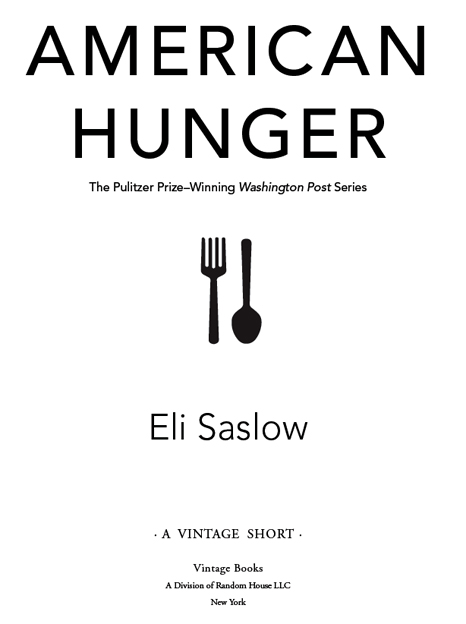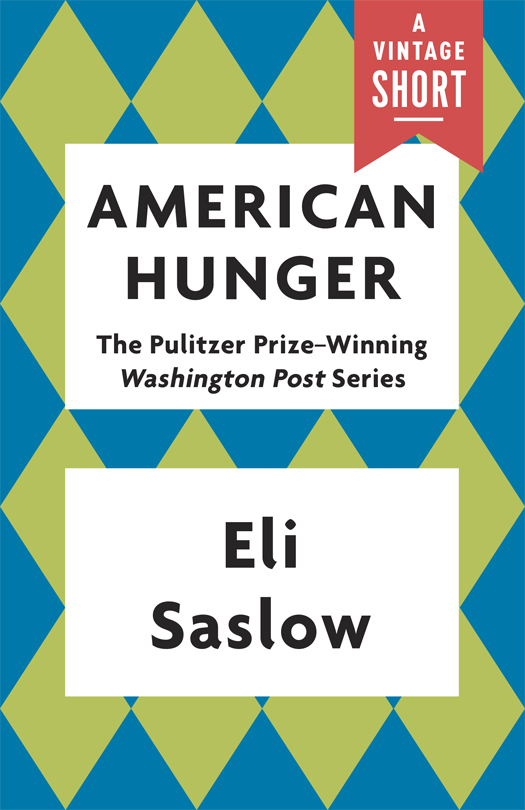
FIRST VINTAGE BOOKS EBOOK EDITION, AUGUST 2014
Copyright 2013, 2014 by Eli Saslow
All rights reserved. Published in the United States by Vintage Books, a division of Random House LLC, New York, and in Canada by Random House of Canada Limited, Toronto, Penguin Random House companies.
Vintage Books and colophon are registered trademarks of Random House LLC.
The text of American Hunger first appeared as a series of articles in The Washington Post in 2013. Copyright 2013 by The Washington Post.
Vintage eBook ISBN: 978-1-101-87389-2
Photographs by Michael S. Williamson
Cover by Joan Wong
www.vintagebooks.com
v3.1
Eli Saslow is a staff writer for The Washington Post and a contributor to ESPN The Magazine. He has won a Pulitzer Prize for explanatory reporting, a George Polk Award for national reporting, and been a finalist for the Pulitzer Prize in feature writing. His first book, Ten Letters: The Stories Americans Tell Their President, was published by Doubleday in 2011. He lives in Takoma Park, Maryland, with his wife and two daughters.
 elisaslow
elisaslow
BOOKS BY ELI SASLOW
Ten Letters: The Stories Americans Tell Their President
CONTENTS
Introduction
Early last year, before I understood that a food crisis exists in parts of America, I was sitting in the Rhode Island kitchen of a woman named Rebecka Ortiz. She and her husband owned a nice two-bedroom apartment in a New England town. She had a full-time job, and he did, too. She described her family as pretty much middle-class. But as we spoke, she was emptying the remaining food in their refrigerator into a pot on the stove to make a dish she called Rice-A-Whatever for her two children. It was beans, canned vegetables, boiled noodles and salt. It was all they had left, and they would eat it for the next three days.
I know nobody actually starves to death in America, Ortiz told me. But there are still days when I obsess about eatingwhen will we do it next? Will there be enough? How will we pay for it? I am always worrying about food.
What I learned during the next year is that much of America now spends its energy worrying about food, the most essential of all essentials. The government food stamp program has tripled in size during the last decade, growing to serve 47 million Americans at a cost of nearly $80 billion each year. The stock market is rising and much of the economy has recovered, but hunger remains the lasting scar of the recession. Nearly 1 in 7 Americansand almost a quarter of all childrennow receive food stamps, the highest participation in the programs history.
Even if nobody starves to death in the U.S., food insecurity has shaped a new economy that revolves around the first of each month. Families ration their meals until their food stamps arrive. Grocery stores do their best business on the first of the month. Towns rely on a historic influx of federal food stamp money, while Washington politicians debate whom the government should feed and for how long.
I spent a year traveling the country to write about food stamps, embedding for several days with six different families to watch this cycle unfold. On the first day of any reporting trip, I always felt a little like an intruder breaking into others lives. Most of the people in these stories had not been written about before. Some had never talked to a journalist or heard of The Washington Post. To them, on that first day, I was not just a reporter asking questions; I was a stranger who arrived out of nowhere with an impossible request: to be allowed to follow these individuals during a time in their lives when they were hungry, sick, broke or stressedand then to write about and share those vulnerabilities with thousands of strangers.
In every case, I expected them to tell me: No. Sorry. I have enough to worry about. Not interested. I would have understood that.
And yet each one of them said yes. They let me into the dark corners of their lives. They introduced me to their families and coworkers. They let me sit in their kitchens as their refrigerators emptied and their fears grew.
I waited with the Laughren family in their trailer in Greenville, Tenn., as they counted the hours until a school bus delivered their one reliable meal of the day. I listened to a doctor in McAllen, Texas, tell Blanca Salas that her 9-year-old son had diabetes and high blood pressure resulting from a food stamp diet of cheap and fatty foods. I sat in Florida with a proud 60-year-old man named Lonnie Briglia as he told his wife that they might need to sign up for food stamps for the first time in their lives. This is killing me, he told her. Its so hard to accept.
The people in these storiesmost people, reallyare trusting and generous and crave to be understood. I hope these stories justify that trust and reflect some of that goodness.
I met Raphael Richmond, the last woman I followed for this series, a few weeks before Thanksgiving. Her food stamp allotment had just been reduced by 10 percent because of a government cut, and she was still trying to scrape together enough food to feed her six children. There was a food bank that operated near their home in Washington, D.C., on Saturday mornings, and I went there with her. She had neither a car nor a babysitter, so she woke up her kids at 5:30 a.m. and marched them into the cold with a couple of empty plastic bags. She was out of money and out of food stamps. This was the best option she had left.
Unfortunately, in the economy of 2013, this was also the best option for a lot of people, so by 6 a.m. the line at this food bank stretched down the block. We waited for a few hours, until we could see people at the front of the line come out of the food bank with what Raphael called the good stuff. They had cans of beans, soda, pies and turkeysa bounty that everyone knew wouldnt last long. The food bank was running out. People in the line started to panic. Somebody tried to steal a turkey. By the time we finally reached the front of the line, the only thing left was a mound of aging sweet potatoes. Thank you, Raphael told a food bank volunteer, forcing a smile. She filled her two bags with sweet potatoes and left.
Raphael was resourcefuland also a good cookand she turned those sweet potatoes into soup, a side dish and dessert for Thanksgiving. A relative brought over a turkey donated by another food bank. A neighbor came with soda paid for with food stamps. Raphael invited a dozen people to come share her sweet potatoes, and they managed what she called a great American meal.
This is what a great meal sometimes looks like in parts of post-recession America. These are the stories of what an American meal sometimes requires.
Eli Saslow
Chapter 1
Rep. Steve Southerland believes in hard work. And thats what he got.
Rep. Steve Southerland (R-Fla.) at the Capitol.
The congressman had been called a starvation expert by analysts on TV and a monster by colleagues in the House of Representatives. Protesters had visited his offices carrying petitions demanding he resign. And now, six months into his crusade to overhaul the food stamp program, Rep. Steve Southerland (R-Fla.) departed the Capitol to address his most wary audience yet: the people whose government benefits he hoped to curtail.










 elisaslow
elisaslow